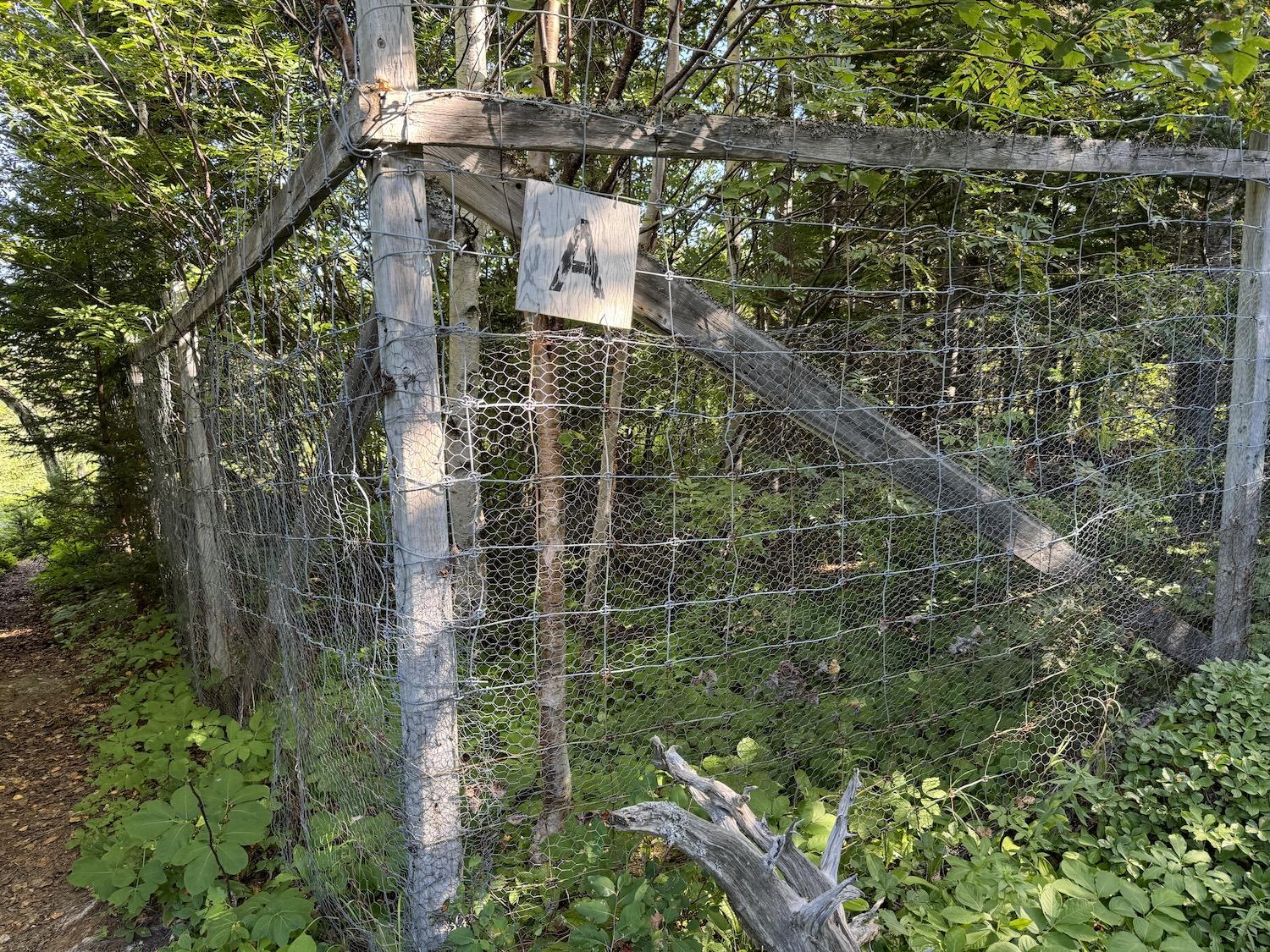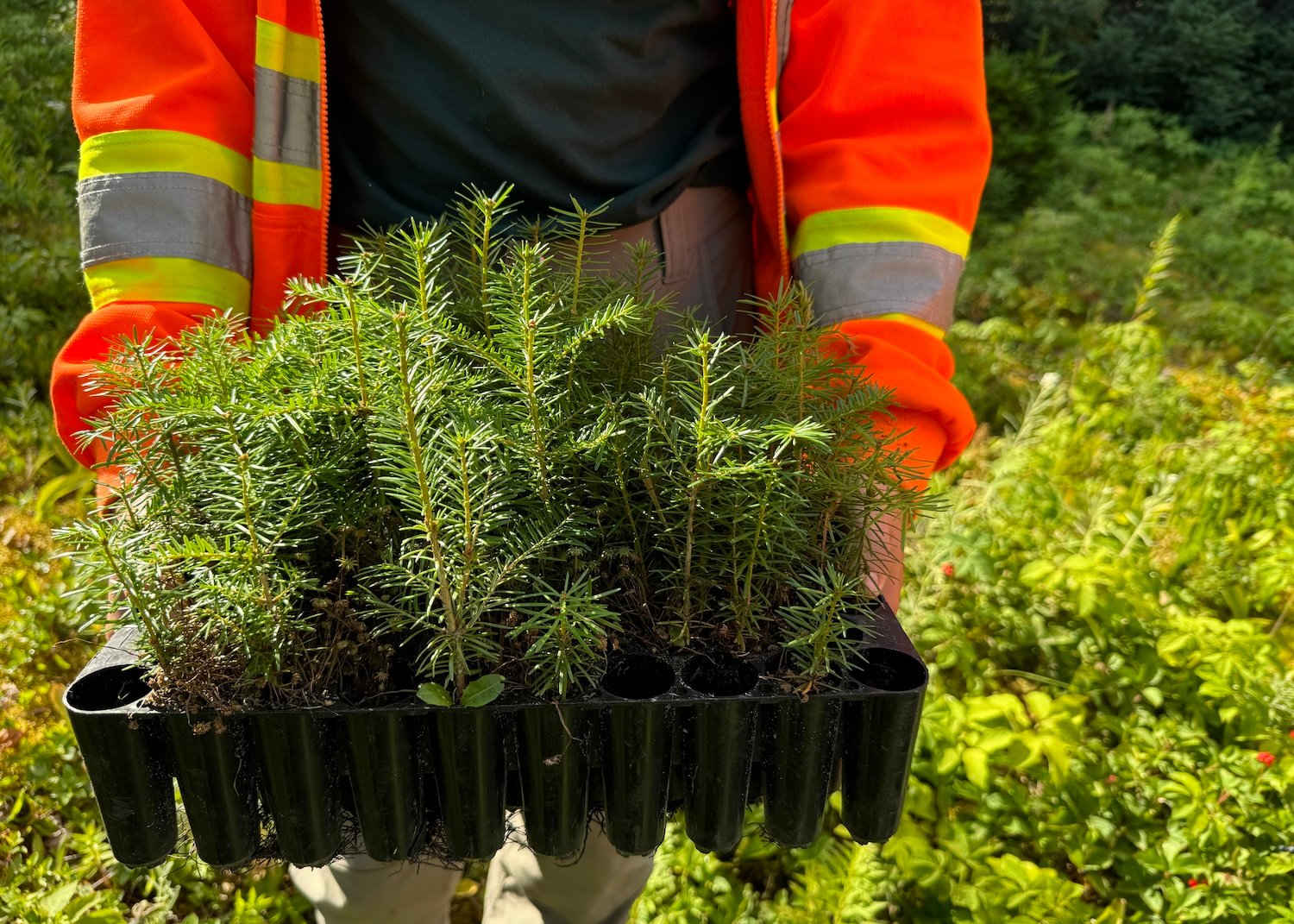It’s just one tree, but it’s a balsam fir that I planted and get to watch grow knowing I’ve helped Terra Nova National Park boost the biodiversity of its forest. Now I have incentive to do more than whiz through Canada’s most easterly park on my way to my summer cottage in Fogo Island in Newfoundland and Labrador.
See, Terra Nova isn’t showy like Gros Morne National Park, a UNESCO World Heritage Site about five hours west of here with a landlocked freshwater fjord, bucket list mountains, Indigenous experiences and a rare outcrop of the Earth’s mantle. It’s a much more subtle wilderness park that protects boreal forest, woodlands, bogs, ponds and North Atlantic Ocean coastlines.
Sure, it’s a Dark Sky Preserve and you might luck into seeing whales and icebergs from shore, but camping is the biggest draw. There's a 27-mile stretch of Trans-Canada Highway through the park and a lot of people drive straight through. We usually only stop when nature calls.

The Terra Nova National Park team meets at the Forest Demonstration Plot to plant balsam fir seedlings in August/Jennifer Bain
But this summer I did stop and explored three reasons to protect the park's trees. First I experienced the Plant-A-Tree program, part of Canada’s 2 Billion Trees commitment to tackle climate change and biodiversity loss by 2031. Anyone can join the special weekly program in July and August, but I met Parks Canada’s team for a private session.
“People tend to be very excited that they can put trees in the park and then monitor them over the coming years,” Conservation and Restoration Program coordinator Hilary Turner told me.
We met at the Forest Demonstration Plot by the moose exclosure on the road to the Blue Hill lookout. Turner brought Hayley Feltham (a resource conservation technician), several summer interns and a tray of balsam fir seedlings.

Terra Nova is planting trees in this Blue Hill meadow that was overbrowsed by moose, which aren't native to the island/Jennifer Bain
Five interpretive signa on a platform overlooking the plot relayed the backstory.
“Prior to the 1980s, the area you see before you was a dense forest made up of a mixture of balsam fir, black spruce and various hardwoods,” the first sign read. “This type of forest was typical in the park.”
Spruce budworm and hemlock looper first attacked this area in the 1980s and 1990s — a natural occurring process of forest regeneration. Insects kill the older trees, opening the forest canopy and allowing sunlight to reach the forest floor to help seedlings take root.

Newfoundland motorists must beware of moose, as this sign in Gros Morne National Park warns/Jennifer Bain
But moose “browsed” (devoured) the new growth, killing or severely damaging the next generation of forest. Forested areas that are taken over by grass and shrubs are nicknamed “moose meadows.”
Moose aren’t native to the island of Newfoundland. Introduced in 1904, they weigh up to 1,300 pounds and are a beautiful menace. They’re prone to running across roads so if you hit one — dawn or dusk are especially dangerous — you can be killed or your vehicle might be totalled.
The voracious herbivores eat at least 44 pounds of twigs a day and love young balsam fir, white birch, trembling aspen and red maple. In Terra Nova’s visitor center on the shore of Newman Sound, there’s a clear box that contains one day’s food for a single moose. Just imagine what a year’s worth of browse — 16,000 pounds — looks like and how that damages the face of this park.

This moose exclosure can be found at Terra Nova's Forest Demonstration Plot on the way to the Blue Hill Lookout/Jennifer Bain
Terra Nova has been building moose exclosures (fenced plots of land) since the mid-1990s to prevent moose from eating young trees. When I peered into the one by the Forest Demonstration Plot, I could see exactly how a healthy forest should look.
“In the absence of predators and with an abundant food supply, the moose population has increased dramatically across the island,” the signage continued. “Parks Canada was faced with a very difficult choice — do nothing, and allow moose to permanently change the forest in our park or begin a major intervention.”
The park started a controlled moose harvest in 2011. This season there will be 25 regular and 15 not-for-profit moose hunting licences issued through the provincial draw system. This should help reduce the population, relieve the browsing pressure on young trees and allow a healthy boreal forest to return.

Terra Nova National Park has been inviting visitors to help plant trees and then watch them grow/Jennifer Bain
Which brings us back to the balsam fir that I planted.
The Plant-A-Tree program hopes to encourage some of the park's 40,000 annual visitors to connect with — and restore — the forest through conservation action. People plant tree seedlings (grown at a nursery from seeds collected in the park), customize tags, take photos and receive certificates.
So far, about 100 people have taken part. The program ran in July and August this year.

Visitors label the tree seedlings that they plant with these personalized tags/Jennifer Bain
Standing in a meadow that August day, I used a shovel to loosen the earth, dropped a seedling into the hole and patted the dirt down. Then I scrawled my name on the aluminum plant tag that helps identify these trees to Parks Canada and the people who planted them.
I wrote “Bain” on mine — etching the letters into the pliable tag — but spotted one that said “Terra Nova Tree” and another that said “bf-14N.” That’s Parks Canada code for “balsam fir” and the fact is was the 14th natural (not planted) tree marked here.
“Hopefully the wind doesn’t blow it or the crows don’t take them,” Feltham said, and I pictured a gleeful bird feathering its nest with my silver tag.

Terra Nova is home to some blue felt lichen, a species of special concern that usually lives on old-growth yellow birch, mature trembling aspen or even white spruce trees/Parks Canada
With my tree quickly planted, there was time to see two of Terra Nova’s tree-loving species at risk, starting with Degelia plumbea — blue felt lichen.
This leafy lichen is blue-grey topped with red-brown to black apothecia (its fungal partner). Pollution is a threat to this sensitive species of special concern. So are moose whose browsing reduces the old-growth yellow birch, mature trembling aspen and white spruce trees it lives on.
The Parks Canada team took me to the forest steps away from the Newman Sound Campground kiosk to see this strangely beautiful lichen on a couple of aspens.

Resource conservation technician Hayley Feltham points to blue felt lichen above red flagging tape/Jennifer Bain
It was more of a dark gray than blue, but Feltham said lichen changes color when it’s wet and these two patches will be almost white by winter. She carries a spray bottle for surveys in late fall and winter and ties red flagging tape around trees with rare lichen on them.
If the lichen is low enough on a tree, she’ll put one ribbon above it and another below it, tying a knot in the ribbon and lining it up where the lichen is.
Should I ever find myself near the campground again, I'll know exactly where to go to check in on this lichen. Should I ever run into another park tree with red flagging tape on it, I'll know to take a closer look for lichen.

Terra Nova is home to the elusive Newfoundland marten, a threatened species and relative of the American marten/Parks Canada
The final tree-loving species I hoped to see was the Newfoundland pine marten (Martes Americana atrata), but I knew that was a longshot.
This omnivore with an orange throat patch and dark brown fur is part of the weasel family and a sub-species of American marten. It loves conifer forests with plenty of canopy closure, and lives and rests in dens, burrows, holes, crevices and hollowed trees.
The marten was once on the verge of extinction because of trapping, snaring and habitat loss but has been rebounding. There were an estimated 630 and 875 on the island in the mid-1980s. When that number dropped to about 300 a decade later, the species was declared endangered. Now there are between 286 and 556 adults and the Committee on the Status of Endangered Wildlife in Canada (COSEWIC) has downgraded the marten to threatened.

The wildlife underpass at Terra Nova's Southwest Brook day-use area/Jennifer Bain
Terra Nova runs a marten reintroduction program and reports the animals are doing well and beginning to disperse to areas outside the park. The population is still at risk because of snaring and trapping outside of protected areas, so public awareness is key.
Staff like Feltham monitor the health of the population by live-trapping martens and collecting biophysical information such as age, sex, hair samples, weight and dental health.
I didn't get to join a monitoring session, but did visit the Southwest Brook day-use area — not far from the Forest Demonstration Plot — to see one of Terra Nova’s four wildlife underpasses that help animals safely cross under the Trans-Canada Highway to find food, shelter, water and mates.

A Newfoundland marten scurries through a wildlife underpass in Terra Nova National Park. This image was caputred by a remote camera installed in the culvert/Parks Canada
We didn't luck into seeing the elusive martens. But I saw a culvert cam photo of one racing through the underpass on a ledge over the water. And I heard how, during monitoring last fall, staff recaptured three martens that had already been tagged plus two new ones they named Ruby and Willy.
As I planted a tree, admired lichen and looked for marten, my family enjoyed outdoor time by the visitor center. Kids adore the touch tank full of sea stars and rock crabs, and everyone loves the aquariums showcasing local lobster, crabs, cod and frilled anemones. There’s an impressive birch bark canoe like the kind the Mi’kmaq people once used to navigate the interior of Newfoundland. There are even kayak rentals.
But when I took a quick look around, I only had eyes for the taxidermied Newfoundland marten and the upbeat message written alongside its display case. “With continued vigilance and protection," an interpretive sign said, the animal "is becoming a lasting success story of rebound and recovery." We got back in the car and hit the highway, certain that we would now make time for Terra Nova when we pass through, to keep tabs on my growing tree and perhaps even go for a quick kayak.

Unless you get really lucky, the only Newfoundland marten you're likely to see at Terra Nova is in a display case in the visitor center/Jennifer Bain



 Support Essential Coverage of Essential Places
Support Essential Coverage of Essential Places







Add comment